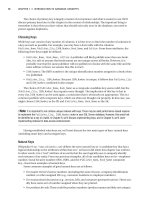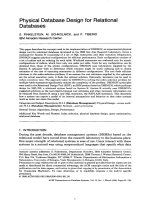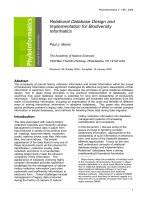Relational database design algorithms and further dependencies
Bạn đang xem bản rút gọn của tài liệu. Xem và tải ngay bản đầy đủ của tài liệu tại đây (1.11 MB, 66 trang )
Relational Database Design
Algorithms and Further
Dependencies
Chapter Outline
0. Designing a Set of Relations
1. Properties of Relational Decompositions
2. Algorithms for Relational Database Schema
3. Multivalued Dependencies and Fourth Normal Form
4. Join Dependencies and Fifth Normal Form
5. Inclusion Dependencies
6. Other Dependencies and Normal Forms
DESIGNING A SET OF RELATIONS (1)
The Approach of Relational Synthesis (Bottom-up
Design) :
Assumes that all possible functional dependencies
are known.
First constructs a minimal set of FDs
Then applies algorithms that construct a target set of
3NF or BCNF relations.
Additional criteria may be needed to ensure the the
set of relations in a relational database are
satisfactory (see Algorithms 11.2 and 11.4).
DESIGNING A SET OF RELATIONS (2)
Goals:
Lossless join property (a must) – algorithm 11.1
tests for general losslessness.
Dependency preservation property – algorithms 11.3
decomposes a relation into BCNF components by
sacrificing the dependency preservation.
Additional normal forms
– 4NF (based on multi-valued dependencies)
– 5NF (based on join dependencies)
1. Properties of Relational Decompositions (1)
Relation Decomposition and Insufficiency of Normal
Forms:
Universal Relation Schema: a relation schema R={A1, A2, …,
An} that includes all the attributes of the database.
Universal relation assumption: every attribute name is
unique.
Decomposition: The process of decomposing the universal
relation schema R into a set of relation schemas D = {R1,R2,
…, Rm} that will become the relational database schema by
using the functional dependencies.
Properties of Relational Decompositions (2)
Relation Decomposition and Insufficiency of Normal
Forms (cont.):
Attribute preservation condition: Each attribute in
R will appear in at least one relation schema Ri in the
decomposition so that no attributes are “lost”.
Another goal of decomposition is to have each
individual relation Ri in the decomposition D be in
BCNF or 3NF.
Additional properties of decomposition are needed to
prevent from generating spurious tuples
Properties of Relational Decompositions (3)
Dependency Preservation Property of a Decomposition
:
Definition:
Given a set of dependencies F on R, the projection of
F on Ri, denoted by pRi(F) where Ri is a subset of R, is
the set of dependencies X Y in F+ such that the
attributes in X υ Y are all contained in Ri. Hence, the
projection of F on each relation schema Ri in the
decomposition D is the set of functional dependencies
in F+, the closure of F, such that all their left- and
right-hand-side attributes are in Ri.
Properties of Relational Decompositions (4)
Dependency Preservation Property of a Decomposition
(cont.):
Dependency Preservation Property: a decomposition
D = {R1, R2, ..., Rm} of R is dependency-preserving
with respect to F if the union of the projections of F on
each Ri in D is equivalent to F; that is, ((πR1(F)) υ . . .
υ (πRm(F)))+ = F+
(See examples in Fig 10.12a and Fig 10.11)
Claim 1: It is always possible to find a dependencypreserving decomposition D with respect to F such that
each relation Ri in D is in 3nf.
Relation Q(A,B,C) and F={A→B,B→C,C→A}. Decomposition of ρ=(Q1,Q2) into Q1(A,B) and Q2(B,C) is
dependency-preserving?
Step 1: List all subsets of Q 1+
∅, A, B, AB
Step 2: Find closure of all subsets of Q 1+
∅+=∅ ,
A+=ABC
B+=ABC
AB+ =ABC
Step 3: Find F1+= π Q1(F)
A→B,
A→AB,
B→A,
B→AB
Step 4: List all subsets of Q 2+
∅, B, C, BC
Step 5: Find closure of all subsets of Q 2+
∅+=∅,
B+=ABC
C+=ABC
BC+=ABC
Step 6: Find F2+= π Q2(F)
B→C,
B→BC,
C→B,
C→BC
Step 7: G=ΠQ1(F)∪ΠQ2(F)={A→B,A→AB,B→A,B→AB,B→C,B→BC,C→B,C→BC}
F={A→B,B→C,C→A} has A→B, B→C are members of G.C→A is a member of G or not? Find CG+. CG+=ABC ⇒
C→A is a member of G. Thus, Decomposition of ρ=(Q1,Q2) into Q1(A,B) and Q2(B,C) is dependency-preserving.
Relation Q(C,S,Z) and F={CS→Z,Z→C}. Decomposition of ρ=(Q1,Q2) into Q1(S,Z) và Q2(C,Z) is dependencypreserving?
Answer:
Step1: List all subsets of Q1+
∅, S, Z, SZ
Step 2: Find closure of all subsets of Q1+
∅+=∅
S+=S
Z+=ZC
SZ+=CSZ
Step 3: Find F1+= π Q1(F)
∅
Step 4: List all subsets of Q2+
A B
∅, C, Z, CZ
Step 5: Find closure of all subsets of Q2+
∅+=∅
C+=C
Z+=ZC
CZ+=CZ
∅ A B
A
B
Step 6: Find F2+= π Q2(F)
Z→C
Z→ZC
Step 7:
G= π Q1(F) υ π Q2(F) ={Z→C,Z→ZC}≡{Z→C}is not equivalent to F ={CS→Z,Z→C}.Thus,Decomposition of
ρ=(Q1,Q2) into Q1(A,B) and Q2(B,C) is not dependency-preserving .
Properties of Relational Decompositions (9)
Testing Binary Decompositions for Lossless Join
Property:
Binary Decomposition: decomposition of a relation R
into two relations.
PROPERTY LJ1 (lossless join test for binary
decompositions): A decomposition D = {R1, R2} of R
has the lossless join property with respect to a set of
functional dependencies F on R if and only if either
–
The f.d. ((R1 ∩ R2) (R1- R2)) is in F+, or
–
The f.d. ((R1 ∩ R2) (R2 - R1)) is in F+.
Properties of Relational Decompositions (9)
Testing Binary Decompositions for Lossless Join
Property:
Binary Decomposition: decomposition of a relation R
into two relations.
PROPERTY LJ1 (lossless join test for binary
decompositions): A decomposition D = {R1, R2} of R
has the lossless join property with respect to a set of
functional dependencies F on R if and only if either
–
Q1+ ∩ Q2+ = X
–
Q1+ ∪ Q2+ = Q+
–
X → Q2+ or X → Q1+
Properties of Relational Decompositions (10)
Successive Lossless Join Decomposition:
Claim 2 (Preservation of non-additivity
successive decompositions):
in
If a decomposition D = {R1, R2, ..., Rm} of R has the lossless
(non-additive) join property with respect to a set of functional
dependencies F on R, and if a decomposition Di = {Q1, Q2, ...,
Qk} of Ri has the lossless (non-additive) join property with
respect to the projection of F on Ri, then the decomposition D2 =
{R1, R2, ..., Ri-1, Q1, Q2, ..., Qk, Ri+1, ..., Rm} of R has the nonadditive join property with respect to F.
Properties of Relational Decompositions (9)
Q(SAIP), Q1 =(SA) , Q2 =(SIP) F={S→A,SI→P}.
Decomsition of Q into Q1 and Q2 has lossless join
property?
Answer:
Q1+∩Q2+=S
Q1+∪Q2+=SAIP=Q+
S→SA=Q1+
⇒ r=r.Q1|><|r.Q2. ⇒ the decomposition of Q in Q1 and
Q2 has lossless join property.
Properties of Relational Decompositions (9)
R = (A, B, C, D, E). We decompose it into
R1 = (A, B, C), R2 = (A, D, E).
The set of functional dependencies is: A → BC,
CD → E, B → D, E → A.
Show that this decomposition is a lossless-join
decomposition.
Answer:
R1 ∩ R2 = A; (A → BC) (A → ABC) (R1 ∩ R2 → R1)
this is a lossless-join decomposition.
Properties of Relational Decompositions (5)
Lossless (Non-additive) Join Property of a Decomposition:
Definition:
Lossless join property: a decomposition D = {R1, R2, ..., Rm} of
R has the lossless (nonadditive) join property with respect to
the set of dependencies F on R if, for every relation state r of R
that satisfies F, the following holds, where * is the natural join of
all the relations in D:
* (πR1(r), ..., πRm(r)) = r
Note: The word loss in lossless refers to loss of information, not
to loss of tuples. In fact, for “loss of information” a better term
is “addition of spurious information”
Properties of Relational Decompositions (6)
Lossless (Non-additive) Join Property of a Decomposition (cont.):
Algorithm 11.1: Testing for Lossless Join Property
Input: A universal relation R, a decomposition D = {R1, R2, ..., Rm}
of R, and a set F of functional dependencies.
1. Create an initial matrix S with one row i for each relation Ri in
D, and one column j for each attribute Aj in R.
2. Set S(i,j):=bij for all matrix entries. (* each bij is a distinct
symbol associated with indices (i,j) *).
3. For each row i representing relation schema Ri
{for each column j representing attribute Aj
{if (relation Ri includes attribute Aj) then set S(i,j):= aj;};};
(* each aj is a distinct symbol associated with index (j) *)
Properties of Relational Decompositions (7)
Lossless (Non-additive) Join Property of a Decomposition (cont.):
Algorithm 11.1: Testing for Lossless Join Property (cont.)
4. Repeat the following loop until a complete loop execution results
in no changes to S
{for each functional dependency X Y in F
{for all rows in S which have the same symbols in the columns corresponding to
attributes in X
{make the symbols in each column that correspond to an attribute in Y be the
same in all these rows as follows: if any of the rows has an “a” symbol for the
column, set the other rows to that same “a” symbol in the column. If no “a”
symbol exists for the attribute in any of the rows, choose one of the “b” symbols
that appear in one of the rows for the attribute and set the other rows to that
same “b” symbol in the column ;};};};
5.
If a row is made up entirely of “a” symbols, then the
decomposition has the lossless join property; otherwise it does not.
Properties of Relational Decompositions (8)
Schema < R=ABC , F = { A→B }> and partition D2= { AB, BC }
Consider the decompositions
D1= { AB, AC } and
D2= { AB, BC }
Observe that D1is a „good‟
decomposition (lossless) while D2is not.
Phantom /Spurious rows created when using
decomposition D2
Properties of Relational Decompositions (8)
Schema < R=ABC , F = { A→B }> and partition D1= { AB, AC }
Consider the decompositions
D1= { AB, AC } and
D2= { AB, BC }
Observe that D1is a „good‟
decomposition (lossless) while D2 is not.
Notice that r’ = πAB(r) * πAC(r)
Properties of Relational Decompositions (8)
Schemas < R1= ABC, F1= { A→BC, C →B } > and
< R2= BCD, F2 = { C →B, B →C, D →B }
Observe that r1≠ r1’
r1 tuple <2,2,6> is lost
in the JOIN and does not
appear in r1’
Properties of Relational Decompositions (8)
Lossless (nonadditive) join test for n-ary decompositions.
(a) Case 1: Decomposition of EMP_PROJ into EMP_PROJ1 and EMP_LOCS fails test. (b) A
decomposition of EMP_PROJ that has the lossless join property.
Properties of Relational Decompositions (8)
Lossless (nonadditive)
join test for n-ary
decompositions.
(c) Case 2:
Decomposition of
EMP_PROJ into EMP,
PROJECT, and
WORKS_ON satisfies
test.
Properties of Relational Decompositions (8)
Example 1: Consider the schema R=ABCD, subjected to FDs
F= { A → B, B → C }, and the Non-binary partition
D1= {ACD, AB, BC}.
Question: Is D1a Lossless decomposition?
Properties of Relational Decompositions (8)
Example 2: Consider the schema R=ABCD, subjected to FDs
F= { A→B, B→C }, and the Non-binary partition
D2= {AB, BC, CD}.
Question Is D2 a Lossless decomposition?









